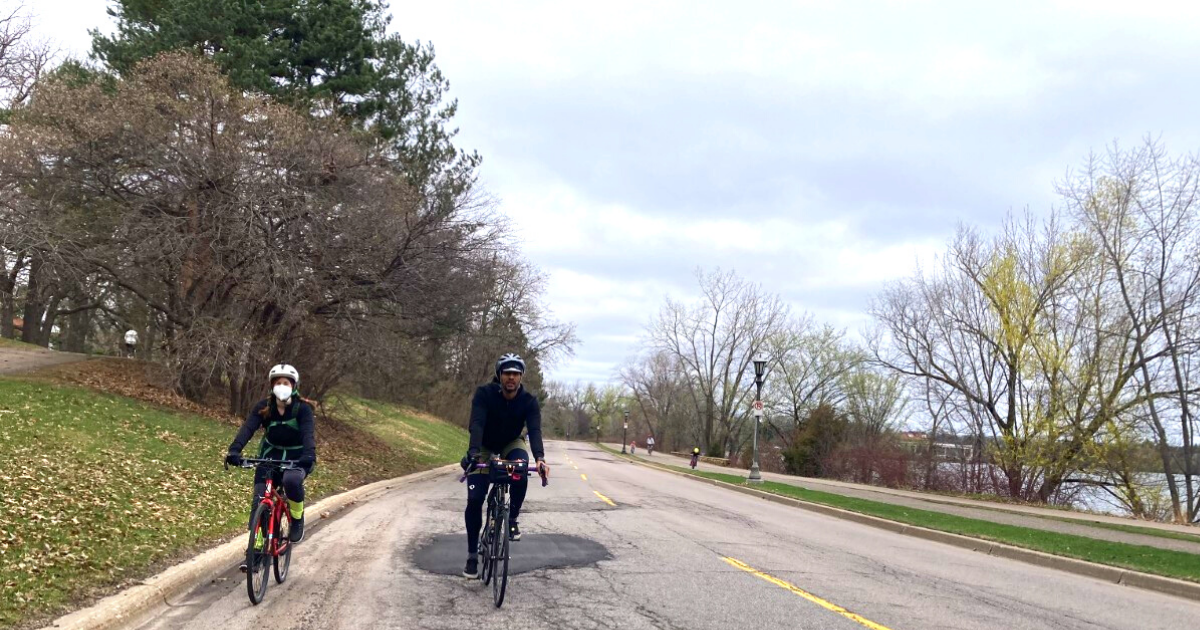Temporarily Transformed Public Spaces in Saint Paul Present Opportunity for Rethinking Streets
Over the course of the pandemic, we’ve seen a year of experimentation as cities in Minnesota and around the country transformed public space. More city streets went car-free to create safer, socially distanced spaces for people biking and walking. Parking lots were closed so that restaurants could expand their seating to the outdoors. People began to work from home at record rates. Transit systems waived their fares. While the cause for some of these changes was dire, many of us wonder if these changes could become permanent infrastructures in the city to better the lives and economy of everyone in it.
Twin Cities Streets and Parking Lots Go Car-Free – For Now
Locally, Move Minnesota’s fall community conversations and our spring survey provided valuable feedback about how to reimagine the future of Saint Paul streets and public spaces together. Thanks to everyone who participated and shared your experiences! An emerging theme from community members is that people want to see current public spaces transformed into more engaging places for gathering, for example converting surface parking areas into other uses.
Already, Saint Paul is making progress in rethinking street design and usage. Just recently the City announced they will be temporarily opening four city roads to people bicycling and walking–and closing them to car traffic–to enable more physically distant activity outdoors. The changes began April 18th and will last until mid-July. The roads are: East Como Lake Drive from East Como Boulevard to Lexington Parkway, East Shore Drive from Johnson Parkway to Arlington Avenue, Cherokee Heights Boulevard from Baker/Chippewa to Annapolis, and the Mississippi River Boulevard from Ford Parkway to Pelham Boulevard. In addition to designating this street space for biking and walking, Mayor Carter also extended an executive order which allows for expanded use of outdoor spaces saying, “Now more than ever, safe outdoor spaces for recreation and exercise are critical to our collective health and wellbeing. . . . We invite our residents, workers, and visitors to join us in utilizing these spaces as we move through these challenging times together.” An example of this includes making temporary sidewalk cafes and other right-of-way obstruction permits available to support restaurants and businesses.
On the other side of the river, Minneapolis will be opening two parkways to people bicycling and walking, and closing them to car traffic, once again this summer. The northbound lane on West River Parkway will be opened up for biking and walking between 4th Avenue N and 11th Avenue S and Lake Harriet Parkway will be opened up for biking and walking between W Minnehaha Parkway and W 43rd Street. For more information on these car-free zones see here.
The trend toward rethinking streets and public spaces accelerated last summer during the beginning of the pandemic as cities across the world temporary closed streets to car traffic so people could bike and walk with more space. These changes also allowed for more people to plan group bike rides with their families. Bike trails and lanes are great, but can provide limited space for those riding in a group such as families with small children. The open parkways around the city allow for children to ride freely and parents to relax, knowing there are less opportunities for conflict. Additional space for dining outdoors in areas usually reserved as parking lots has allowed restaurants to continue to operate during this pandemic, and offers people a place to gather in a fresh air environment.
Permanent Changes to Put People First
Reimagining how we use streets and public spaces is not just happening in the Twin Cities. Around the country, cities have experimented with streets during the pandemic, and as we see the end to the pandemic on the horizon, folks must decide if these changes were a passing trend or a permanent improvement. In Seattle, 20 miles of car-free streets will become permanent. In New York, curbside outdoor dining will become a permanent feature. But in other cities the path forward isn’t as clear. Oakland continuously engaged the community to make sure their car-free streets were working for residents, but their long-term future is undecided. Likewise in Chicago, bus lanes, extended crosswalks, and streets closed to car traffic could become permanent if they get enough support in the near future. In a recent survey of close to 100 U.S. mayors, only a handful thought the pandemic changes to streets and public spaces would be made permanent. Elected officials need to know that residents appreciate these changes to streets for them to become a part of the future and not just a blip of the pandemic past.
Saint Paul can be one of the cities that keeps its changes to streets and public spaces. This can be done by:
- Using these spaces. Take advantage of the car-free streets for biking and walking and stay safe while supporting local business by dining outside at a local restaurant. Working from home? Plan to take your lunch break by biking to one of the many amazing restaurants downtown and throughout Saint Paul.
- Letting your elected officials know. Let your city council representative know what you like about these changes or about changes you would like to see! The temporary transformations during this pandemic have demonstrated that redesigning streets for people, and not just cars, is possible. These changes come as biking and walking has increased at incredible rates in the Twin Cities.
As Saint Paul and the rest of the Twin Cities continues to make important progress toward creating more sustainable and accessible streets, residents and decision-makers have an incredible opportunity to create our post-pandemic future, put people first, and be among the leaders in this nationwide movement already underway. Now is the time.

